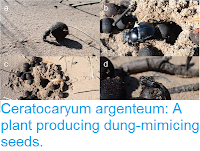Sandlewoods are a widespread group of Broad-leaved Flowering Plants (Dicots), including herbs, shrubs, trees, and epiphytes, many of which, such as the Mistletoes, are parasitic. The genus Thesium contains around 350 herbaceous Sandlewoods found on every continent except Antarctica, though the vast majority are found in Africa, and in particular in the Fynbos Biome of the South African Cape Floristic Region.
In a paper published in the journal PhytoKeys on 2 October 2018, Miguel Angel García of the Real Jardín Botánico and the Royal Botanic Gardens at Kew, Daniel Nickrent of the Department of Plant Biology at Southern Illinois University, and Ladislav Mucina of the School of Biological Sciences at the University of Western Australia, and the Department of Geography and Environmental Sciences at Stellenbosch University, describe a new species of Thesium from Mount Matroosberg in the Hex River Mountains of Western Cape Province, South Africa.
The new species is named Thesium nautimontanum, which is a translation of the Afrikaans word 'Matroosberg' (Sailor's Mountain) into Latin. It is a scaly, hairless, perennial herb, reaching 30-35 mm in height. Its leaves are reduced to small triangles about 1.7 mm in length, its flowers are green in colour and about 2 mm in length, and born in bracts of about 50 on erect spikes.
Thesium nautimontanum. (A) Habit of plant showing sympodial branching, (B) flowering shoot showing squamate condition, vegetative bracts grading into floral bracts and terminal spicate inflorescence, (C) flower, lateral view, (D) flower longitudinal section, (E) young fruit subtended by bract and two bracteoles. Juan Luis Castillo in García et al. (2018).
Thesium nautimontanum was found at two separate locations on Mount Matroosberg, on a lower slope at 1016 m above sealevel, with a sandy acid soil, with a dry scrub vegetation, and close to the summit of the mountain, at 1920 m, in a depression that harboured a moist wetland environment dominated by Grasses and Heathers. This distribution, with plants found in different environments and at different altitudes, is very unusual.
Thesium nautimontanum from the type herbarium specimen. (A) Spicate inflorescence subtended by bracts, (B) close-up of inflorescence bracts, (C) flower, lateral view, showing triangular external glands in corolla lobe sinuses, (D) flower longitudinal section, (E) ovary longitudinal section showing twisted placental column and ovules (one ovule removed to visualise the placentation), (F) close-up view of interior surface of corolla lobes showing unusual fleshy tissue on inner surface of corolla lobes, (G) young fruit showing persistent corolla and reticulate outer wall of ovary. García et al. (2018).
Despite being an important part of the Fynbos Biome of the South African Cape Floristic Region, the Hex Mountains are not currently part of the Cape Floral Region UNESCO World Herritage Site, and the area where Thesium nautimontanum was discovered is not currently protected in any way. Despite this lack of formal protection, the area is not thought to be at any immediate threat from Human activities, as the land is of little agricultural use, and the limited tourism in the area is reliant on the Fynbos remaining undisturbed. The area is prone to wildfires, but this is part of the natural ecological cycle, and most of the plants found here are adapted to cope with it, although any warming and drying of the client could potentially change this balance, making the plants more vulnerable.
Although Thesium nautimontanum was found growing in two separate locations, with very different conditions, the total known area covered by the plant is less than 8.0 km³, for which reason García et al. suggest that the species should be classified as Critically Endangered under the terms of the
International Union for the Conservation of Nature’s Red List of Threatened Species.
See also...
Follow Sciency Thoughts on Facebook.








